Introduction to Camera Tools
In the realm of photography, camera tools encompass a broad array of instruments and accessories that enhance the process of capturing images. These tools play a vital role in both professional and amateur photography, significantly impacting the quality and creativity of the final output. The evolution of camera tools has been remarkable, transforming from basic manual devices to sophisticated technological equipment that enables a greater degree of artistic expression.
Historically, photography began with rudimentary devices that required extensive skill and patience. Early photographers relied on large-format cameras and cumbersome film processes. With advancements in technology, camera tools evolved to include adjustable lenses, tripods, and various lighting options, which expanded the creative possibilities. Nowadays, digital photography has further revolutionized the field, introducing tools such as digital cameras, editing software, and a plethora of accessories designed to streamline the photography process.
Having the right camera tools is essential for photographers, as they directly influence the outcome of a photographic project. Different types of photography, such as portraits, landscapes, and macro photography, demand specific tools that accommodate the unique challenges and requirements of each genre. For instance, landscape photographers may benefit from sturdy tripods to stabilize their cameras in outdoor settings, while portraitists often utilize lighting kits to achieve the desired ambiance. Consequently, understanding the necessity of these specialized tools is crucial for photographers aiming to elevate their craft.
In conclusion, camera tools are indispensable assets that every photographer should consider. From historical context to contemporary innovations, the range of tools available enables photographers to refine their skills and expand their creative boundaries. The pursuit of photography, propelled by the right equipment, fosters not only technical proficiency but also artistic growth. Thus, selecting and mastering the appropriate camera tools is essential for anyone wishing to thrive in this dynamic art form.
Types of Camera Tools
For photographers, understanding the various types of camera tools is crucial for enhancing their photographic skills and outcomes. The most fundamental among these tools are lenses, which significantly affect image quality and composition. Different lenses, such as wide-angle, telephoto, and macro, offer unique perspectives, allowing photographers to capture a variety of scenes. A wide-angle lens is ideal for landscapes, while a telephoto lens excels in wildlife photography by allowing subjects to be captured from a distance without disturbing them.
Another essential tool is the tripod. A good tripod provides stability, enabling photographers to take clear, sharp images even in low-light conditions or during extended exposure times. It is particularly beneficial for landscape and architectural photography, where precision is key to capturing detail and avoiding motion blur.
Filters also play a significant role in enhancing photographic results. Neutral density filters allow for longer exposure times, essential for capturing smooth water flow in landscapes. Polarizing filters help reduce reflections and enhance colors, making them particularly useful for outdoor photography. Each filter type adds a layer of creativity, providing photographers with the ability to experiment with their shots.
Lastly, camera bags are essential for safeguarding equipment during transport. They come in various sizes and designs, offering organization and protection for lenses, cameras, and accessories. A well-designed camera bag enables photographers to keep their gear accessible and secure, ultimately improving their workflow when capturing shots in diverse settings.
In conclusion, the variety of camera tools available today, from lenses and tripods to filters and camera bags, enhances the photographic experience. Each tool serves a specific purpose, contributing to the quality and creativity of photographic work, empowering photographers to explore their artistic capacities fully.
Essential Camera Accessories
For photographers, having the right camera accessories can significantly enhance both the shooting experience and the longevity of the equipment. Among the essential accessories, memory cards stand out as indispensable tools. However, it is crucial to select the appropriate type and capacity to match the specific needs of various shooting scenarios. High-capacity cards with fast write speeds are particularly advantageous for those who shoot in high-resolution formats or capture burst shots. These memory cards not only store images but also ensure that the camera maintains peak performance during critical moments.
Another important accessory is extra batteries. Photographers often find themselves in situations where a single battery may not suffice, especially during long shoots or in remote locations. Having additional batteries ensures that one can confidently capture the desired shots without the fear of running out of power. It is advisable to keep batteries charged and ready, as they play a pivotal role in a seamless shooting experience.
Cleaning kits are also essential for maintaining the optimal performance of camera equipment. Regularly cleaning lenses, sensors, and other parts of the camera helps to avoid dust and smudges that can diminish image quality. A basic cleaning kit typically includes lens wipes, a blower, and microfiber cloths. Utilizing these tools will not only enhance the quality of photographs but also prolong the life of the camera.
Finally, camera straps should not be overlooked. A reliable strap provides security and comfort while handling the camera. Whether a photographer is trekking through rugged terrain or attending events, a sturdy strap can facilitate ease of use and minimize the risk of dropping the camera. Investing in high-quality accessories is essential for any photographer aiming to optimize their workflow and equipment longevity.
Advanced Camera Gear
Professional photographers often seek to elevate their work through the use of advanced camera gear, which goes beyond the fundamental equipment typically employed by enthusiasts. One of the essential tools in a photographer’s arsenal is the external flash. Unlike an on-camera flash that can produce harsh lighting, external flashes allow for creative control over light direction and intensity. This versatility enables photographers to achieve well-lit portraits and commercial images, essential for high-caliber work.
In addition to external flashes, studio lights play a pivotal role in controlled lighting environments. These lights can vary in type, including strobes and continuous lighting. Strobes, which produce a burst of light, are effective for freezing motion in dynamic scenes, whereas continuous lights help visualize the final outcome while adjusting settings in real-time. Both types are fundamental for product photography and studio portraits, where lighting consistency is crucial.
Reflectors are another vital component for professional photographers. They serve to bounce light onto subjects, effectively filling shadows and providing a balanced exposure. Reflectors come in various sizes and colors, allowing for different effects depending on the desired outcome. Photographers can manipulate natural or artificial light using reflectors, enhancing their photography’s overall quality.
Furthermore, the use of sophisticated editing software has become increasingly important in the post-production process. Advanced tools such as Adobe Lightroom and Photoshop enable photographers to retouch images, adjust exposure, and apply creative effects. Mastery of these applications is essential for achieving polished final results, which can significantly elevate a photographer’s portfolio and overall vision.
Incorporating advanced camera gear not only enhances creative possibilities but also allows professional photographers to distinguish their work in a competitive industry. Understanding when and how to effectively utilize these tools is key to mastering the art of photography.
Smartphone Photography Tools
The rise of smartphone photography has significantly transformed the way individuals capture moments, making it accessible to a broader audience. Mobile devices now come equipped with sophisticated camera capabilities, but for those looking to elevate their photography, a variety of external tools are available. These tools not only enhance image quality but also expand the creative potential of users.
One of the most crucial accessories is the external lens. These lenses can dramatically alter the perspective and clarity of smartphone photographs. Options such as fisheye, macro, and telephoto lenses allow photographers to explore different styles and techniques previously limited to traditional cameras. By using clip-on lenses, users can achieve professional-quality results without the need for bulky equipment, making them an excellent choice for amateur and seasoned photographers alike.
Additionally, stabilizers have become increasingly popular among smartphone users seeking to capture smooth, cinematic footage and sharp images. Gimbals and handheld stabilizers help eliminate unwanted motion, allowing for more professional-looking videos and stills. This is particularly beneficial when shooting in dynamic environments or working with long exposure shots where stability is paramount.
Editing apps are another essential tool in the smartphone photographer’s arsenal. With applications like Adobe Lightroom, Snapseed, and VSCO, photographers can manipulate images directly from their devices, applying filters, adjusting lighting, and refining details with easy-to-use interfaces. These apps enable users to achieve a polished look reminiscent of traditional photography editing software, thereby closing the gap between mobile and conventional photography methods.
In conclusion, the combination of external lenses, stabilizers, and advanced editing applications empowers smartphone users to produce stunning photographs that rival those taken with traditional cameras. As technology continues to evolve, the tools available for smartphone photography will undoubtedly enhance creative opportunities for photographers across all levels of expertise.
Budget-Friendly Camera Tools
For photographers who are passionate about their craft yet constrained by a limited budget, there are numerous effective alternatives to premium camera tools that do not compromise quality. One of the first steps is to consider reputable third-party brands that manufacture lenses, tripods, and accessories at a fraction of the cost of leading brands. Many of these alternatives provide similar performance and can significantly enhance a photographer’s toolkit.
When it comes to lenses, explore options like prime lenses that are often less expensive than zoom lenses while still delivering exceptional image quality. Brands such as Yongnuo and Tamron offer budget-friendly lenses that cater to various needs, from portrait photography to wide-angle shots. Utilizing these alternatives opens a new realm of creative possibilities without overspending.
Additionally, DIY solutions can greatly reduce expenses. Creating a homemade diffuser or reflector can improve lighting conditions in your photographs at virtually no cost. Simple materials like white sheets, cardboard, or aluminum foil can be transformed into effective tools that contribute to stunning visuals. You can also create a lens hood with materials easily acquired from craft stores, enhancing image quality by reducing lens flare.
Finding quality tools without breaking the bank can also be achieved through online marketplaces and social media groups where photographers buy and sell used gear. Websites such as eBay, KEH, or even local classifieds feature numerous listings of gently used equipment, which can provide substantial savings. Additionally, keeping an eye out for seasonal sales and clearance events at camera shops can lead to significant discounts on essential photography tools.
Embracing budget-friendly camera tools does not mean sacrificing quality. By exploring alternatives, leveraging DIY creativity, and hunting for deals, photographers can build a robust toolkit that enhances their skills without exceeding their financial limits.
Maintaining Your Camera Tools
Proper maintenance of camera tools is essential for every photographer aiming to achieve optimal performance and longevity from their equipment. Regular cleaning and careful storage not only enhance the functioning of camera gear but also ensure that all components, including lenses and sensor, are in the best possible condition. This maintenance contributes significantly to the overall quality of the photographs captured.
Cleaning camera equipment is a fundamental practice that should be performed regularly. Dust, dirt, and fingerprints can affect image quality. It is advisable to use a soft, lint-free cloth or an air blower to gently remove dust from the camera body and lens surfaces. For lens cleaning, specialized solutions and microfiber cloths are highly recommended, as they prevent scratches and preserve the integrity of the lens coating. Moreover, cleaning should always be carried out in a controlled environment to avoid exposing the equipment to more dust and debris.
Storing camera tools correctly is equally important in maintaining them. When not in use, items should be placed in a dry, cool environment. Humidity can cause mold growth on lenses and damage the internal components of the camera. Using padded camera bags or cases protects equipment from physical impacts, while silica gel packs can help manage moisture levels within the storage area. It is best to avoid leaving camera tools in direct sunlight or in hot vehicles, as excessive heat can cause lasting damage.
Lastly, regular inspections of camera tools are advisable to detect any potential issues before they escalate. Photographers should check for wear on straps, cables, and battery life regularly, as this proactive approach can significantly enhance the lifespan of the equipment. In conclusion, adhering to these maintenance practices ensures that camera tools remain reliable, performing at their best during every shoot.
The Future of Camera Tools
The photography landscape is undergoing rapid transformation due to advancements in technology, reshaping how photographers capture and edit images. One of the most significant trends is the integration of artificial intelligence (AI) in photography. AI-powered tools are revolutionizing the way images are processed, aiding photographers in tasks like image recognition, automatic tagging, and even enhancing image quality through sophisticated algorithms. These innovations not only streamline workflows but also allow for more creative possibilities, enabling photographers to focus on their artistic vision rather than getting bogged down by technical details.
Additionally, the development of smart cameras is at the forefront of this technological evolution. Modern cameras are becoming increasingly intelligent, equipped with features such as object tracking, automatic scene selection, and customizable shooting modes. These smart cameras are designed to analyze subjects and environments in real time, providing photographers with the tools needed to capture stunning images effortlessly. For instance, photographers can benefit from specialized modes tailored for low-light conditions or fast-moving subjects, ensuring optimal results regardless of the circumstances.
Moreover, the growing use of drones in photography has revolutionized aerial imaging and videography. Drones offer photographers unprecedented perspectives and capabilities that were previously out of reach. With high-resolution cameras mounted on drones, it is now possible to capture breathtaking landscapes, events, or architectural marvels from the sky. As drone technology continues to advance, including improvements in battery life, range, and camera quality, the potential applications for aerial photography will only expand further.
Collectively, these innovations underscore a significant shift in photography. As AI, smart cameras, and drones become increasingly embedded in our creative processes, photographers can expect not only enhanced efficiency but also an expanded horizon for artistic expression.
Conclusion: Choosing the Right Camera Tools
In the realm of photography, the selection of appropriate camera tools can significantly influence the outcome of one’s creative endeavors. To ensure photographers can capture the essence of their vision, it is crucial to consider a few key factors when choosing the right tools. Whether you are a novice or an experienced photographer, understanding your unique photography style plays a vital role in this decision-making process.
For instance, landscape photographers may prioritize wide-angle lenses and sturdy tripods to capture expansive vistas with clarity and stability. On the other hand, portrait photographers might favor prime lenses that offer crisp focus and beautiful bokeh effects, enhancing the aesthetic appeal of their subjects. Hence, aligning camera equipment with one’s specific interests is fundamental, as it allows for the exploration of various photographic techniques and styles.
Experience level is another critical consideration. Beginners often benefit from versatile camera kits that include essential tools, such as a reliable camera body, a basic zoom lens, and a sturdy tripod. These fundamental tools provide a solid foundation for learning and experimentation. Conversely, advanced photographers might seek specialized tools tailored to their advanced techniques and creative aspirations, making room for a more tailored selection of lenses, filters, and accessories.
Lastly, budget constraints can impact equipment choices significantly. It is advisable for photographers to establish a budget and research tools that fit within their financial parameters. Whether opting for new or used gear, prioritizing quality is essential to ensure durability and performance. By carefully considering personal photography style, experience level, and budget, photographers can make informed decisions and invest in equipment that truly enhances their artistic journey.






